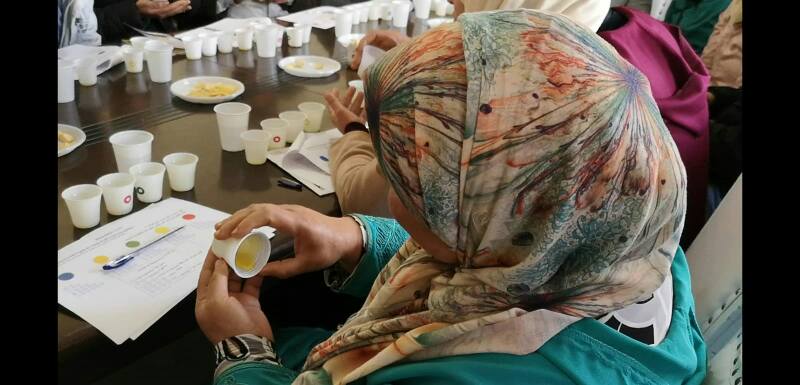When bitter is better: Moroccan consumers learn what to look for in good quality olive oil
 Olive Oil tasting
Olive Oil tastingFruity, bitter and pungent. Those are the hallmarks of a good quality olive oil. But a lot can happen from tree to bottle that can throw off the balance, leaving oils tasting rancid, fusty, musty or vinegary, for example.
A group of Moroccan consumers and industry players sharpened their skills at recognizing good quality olive oils from ones with defects during a series of tastings in Tangiers, Beni-Mellal, and Fes-Meknes.
The tastings, along with trainings on olive oil production techniques, were organized by Interprolive, Morocco’s olive industry association, the Ministry of Agriculture, Fisheries, Rural Development, Water and Forests, the European Bank for Reconstruction and Development (EBRD) and the Food and Agriculture Organization of the United Nations (FAO), with support from the European Union.
These efforts were the latest in an ongoing initiative by the above-mentioned players to raise the profile of Moroccan olive oil, both domestically and abroad.
Morocco’s olive oil industry has excellent potential to become a competitive force thanks to ideal olive growing conditions and good varieties like the Picholine marocaine, which are packed with polyphenols.
One way to transform demand at home is by educating the Moroccan public on what to look for in a good quality olive oil.
“Raising awareness and quality standards across the entire supply chain, and familiarizing producers with modern extraction systems, will help increase the consumption and marketing of olive oils made from the Picholine marocaine, our main variety and an important part of Morocco’s heritage,” said Hssain Rahaoui, Regional Director for Agriculture in the Region of Béni Mellal-Khénifra.
Knowledgeable consumers
During several rounds of blind tastings, participants sampled Moroccan extra virgin and virgin olive oils of varying quality, and rated the oils based on their preferences.
This was followed by a discussion on quality and an explanation of how harvesting, storage, transportation or processing can affect the quality and taste of the oil, either negatively or positively.
Participants were then invited to try the oils a second time to match each explanation with the smell and taste of the oil in order to better recognize the specific traits or defects.
They received a handbook summarizing the key messages, along with advice on how to store olive oil properly at home.
For Latifi Hanane, from the National Food Safety Agency, the training was a revelation.
“I was not aware of what caused the variety of tastes in olive oil. The approach used during the training was really innovative and intuitive. By tasting the final product, we were able to clearly identify what went wrong in the production process. This knowledge is essential for any oil producer but also for anyone working in the value chain,” she said.
The results of the tastings will feed into an FAO/EBRD study on olive oil consumption and commercialization in Morocco – work that is in line with EBRD’s new agribusiness strategy.
“Improving traceability and quality awareness will greatly benefit Moroccan farmers, olive mills, bottlers and consumers. It will allow for greater quality and price differentiation, two pre-requisites for gaining Moroccan consumer confidence and for better organizing and creating value in the domestic olive oil sector,” said Othman Tlemcani, Principal Banker, covering the Agribusiness sector for EBRD in the South and Eastern Mediterranean region.
Quality control at every stage
The olive oil production training, geared specifically for millers, showcased the best practices – and pitfalls to avoid – at each stage.
Leading international experts were on hand to provide technical guidance and practical demonstrations.
The millers, like Mohammed Essafi, President of the GIE of Jenane Ouezzane, received a checklist prepared by the EBRD and FAO to keep track of good practices and note those to be adjusted to ensure a good quality product.
“Improving production techniques and raising awareness among producers is key for raising the quality standards of our olive oil, which would allow for the GIE to grow and develop its linkages with the international market,” he said.
To the next level
The EBRD and FAO will continue to support Interprolive, the MAPM-DREF and partners in taking the olive oil industry to the next level. This means promoting everything from advanced pruning techniques to quality differentiation to greater public-private policy dialogue.
Given the enthusiastic response to these and previous rounds of tastings and trainings, they will also continue to get the word out to Moroccan consumers on what makes a good quality olive oil good – helping build the domestic demand needed for greater private investment and eventually carving out a bigger space in the international market.
